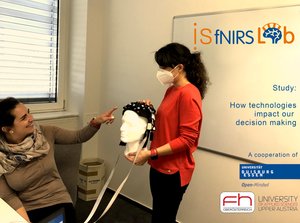Singleview
Tue, 11. May. 2021 Busch, Jan
Forschungsarbeiten aus unserem IIS fNIRS Lab auf NeuroIS-Konferenz akzeptiert
Drei Beiträge aus unserem IIS fNIRS Lab wurden auf der diesjährigen NeuroIS-Konferenz akzeptiert! Dabei streuen sich die abgedeckten Themen von Digital Signages bis hin zu Form und Fabre auf Webseiten. Im Folgenden sind die drei Arbeiten einmal kurz vorgestellt.
Design Mode, Color, and Button Shape: A Pilot Study on the Neural Effects of Website Perception
Authors: Anika Nissen and René Riedl
The investigation of website aesthetics has a long history and has already been addressed in NeuroIS research. The extant literature predominantly studied website complexity, symmetry, and colors. However, other design factors have not yet been examined so far. We studied two new factors (design mode: light vs. dark, button shape: rounded vs. sharp angled) along with color (blue vs. red). Specifically, we examined the impact of these three factors on several outcomes. Results from a repeated-measures MANOVA indicate: (i) design mode (light vs. dark) significantly affects users’ pleasure, arousal, trust, attitude, and use intention, (ii) color (blue vs. red) significantly influences pleasure, arousal, and use intentions, while (iii) button shape (rounded vs. sharp) does not significantly influence any of the dependent measures. Based on these results, follow up functional near-infrared spectroscopy studies are developed which aim to further complement our self-report findings.
Towards a Psychophysiological Investigation of Perceived Trustworthiness and Risk in Online Pharmacies: Results of a Pre-Study
Authors: Anika Nissen and Semra Ersöz
Perceived trustworthiness and risk are crucial impact factors for a website's success. While they have been frequently applied to diverse ecommerce contexts, an investigation of these constructs for the special case of online pharmacies is still scarce. In an attempt to measure these constructs in a neural experiment, this paper offers a pre-study with the aim to gain first insights and select appropriate stimuli for the upcoming study. Therefore, five operating online pharmacies are tested in an online survey with 121 participants which rated scales of perceived trustworthiness, perceived risk, attitude towards the website, and use intention for each of the included pharmacies. Results show that online pharmacies with high reputation are rated higher in the included constructs. Consequently, reputation, perceived risk, and trustworthiness are crucial impact factors on attitude and use intention. Thus, two promising online pharmacies could be selected for the follow-up study
Consumers Prefer Abstract Design in Digital Signage: An Application of Fuzzy-Trace Theory in NeuroIS
Authors: Anika Nissen, Gabriele Obermeier, Nadine Gier, Reinhard Schütte, & Andreas Auinger
Visual designs of digital signage (DS) content shape and influence consumers’ decisions. Understanding the effect of DS design on consumer behavior requires a fundamental understanding of human reasoning and decision-making. This research explores the effect of different visual design cues of DS on a neural level and through the lens of Fuzzy-Trace Theory (FTT). The FTT suggests that humans have both a verbatim-based and a gist-based information processing. To explore the effect of FTT-based visual design, an experiment using functional near-infrared spectroscopy is conducted. DS are tested on three design levels: (1) verbatim: text, (2) verbatim: photographs, and (3) gist-based. Results show that only the gist-based design resulted in significantly higher self-reported results and activated brain areas in the medial prefrontal cortex, which are associated with emotional and rewarding processing. These results challenge the mani- fest differentiation only between image and text elements.
Breaking News:
 IIS-Talents: Erfahrungsberichte zum Event bei mindsquare09.05.23
IIS-Talents: Erfahrungsberichte zum Event bei mindsquare09.05.23- IIS-Talents: Das sind unsere Events für das Sommersemester 2023!25.04.23
 IIS-Publikationen auf der ECIS 2023 angenommen24.04.23
IIS-Publikationen auf der ECIS 2023 angenommen24.04.23 Zwei SHKs für die Unterstützung eines innovativen Lehrkonzepts gesucht! 18.04.23
Zwei SHKs für die Unterstützung eines innovativen Lehrkonzepts gesucht! 18.04.23 IIS-Publikationen auf der ECIS 2023 angenommen17.04.23
IIS-Publikationen auf der ECIS 2023 angenommen17.04.23 IIS-Talents SS 2023 - jetzt bewerben!11.04.23
IIS-Talents SS 2023 - jetzt bewerben!11.04.23 IIS-Talents: Abschlussevent beim Zeche Zollverein Essen23.03.23
IIS-Talents: Abschlussevent beim Zeche Zollverein Essen23.03.23 IIS-Talents: Erfahrungsberichte zum Event bei Grant Thornton14.03.23
IIS-Talents: Erfahrungsberichte zum Event bei Grant Thornton14.03.23 Herzlichen Glückwunsch zur Promotion, Anika!07.03.23
Herzlichen Glückwunsch zur Promotion, Anika!07.03.23 Neuer Wissenschaftlicher Mitarbeiter: Michael Harr07.03.23
Neuer Wissenschaftlicher Mitarbeiter: Michael Harr07.03.23

